St. Louis regional transit planning process as a model for what needs to be done in the DC Metropolitan region
The St. Louis transit planning process underway currently looks to be quite interesting. See the website Moving Transit Forward, as well as "MetroLink Expansion Would Take Many Years, Metro Official Says" from the St. Louis Post Dispatch and the Moving Transit Forward Powerpoint presentation.
There is one public meeting still to come, next week, in this first phase of the public process. There are two more sets of public meetings scheduled, for the release of the draft plan and the response, and then for the release of the final plan.
In the section of the website called "What's My Role?," they have posted (in pdfs) the presentation boards from 5 of the 6 stations. (The sixth station is where people vote for their choices.)
- Station #1 – Moving Transit Forward Overview
- Station #2 – Existing Conditions
- Station #3 – Potential System and Service Enhancements
- Station #4 – Funding Transit
- Station #5 – You Be the Transit Planner (concepts for system expansion)
- Station #6 – What Do You Prefer?
Here are a few particularly interesting ones.
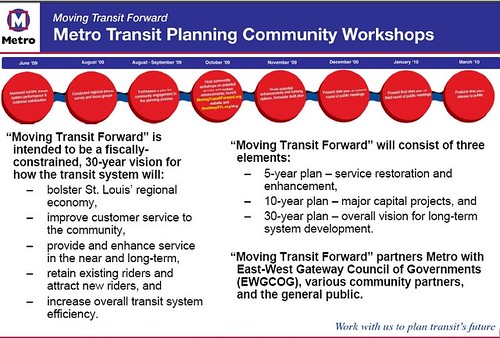
This one is particularly good, because it shows how they are breaking out the system improvement (and expansion) plan into three distinct phases:
“Moving Transit Forward” will consist of three elements:
– 5-year plan – service restoration and enhancement,
– 10-year plan – major capital projects, and
– 30-year plan – overall vision for long-term system development.
This slide discusses the purpose of transit and where it works best.
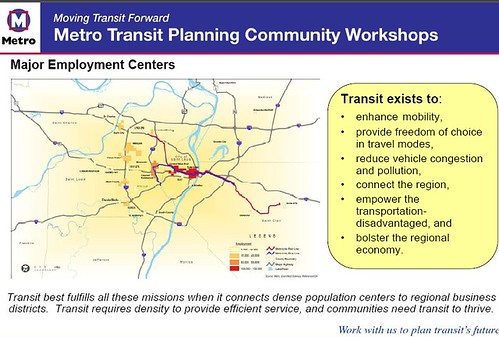
This slide is interesting because in the DC region, the fastest growing transit service is paratransit, and it's breaking the WMATA budget bank. Here it is discussed as a co-equal service. In our region, it's rarely discussed so systematically out in the public sphere.
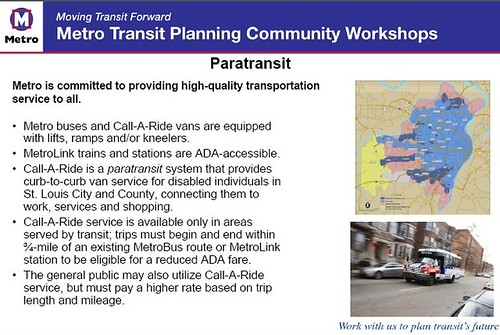
Two boards on funding explain how the local transit system is funded. (They could have had another board on how highways are funded just so that people could start to understand that all mobility is "subsidized.")
This board, from the "You Be The Transit Planner" exercise links cost of service with ideas for service. (It is what is called a constrained planned, focused on what can be reasonably funded.)
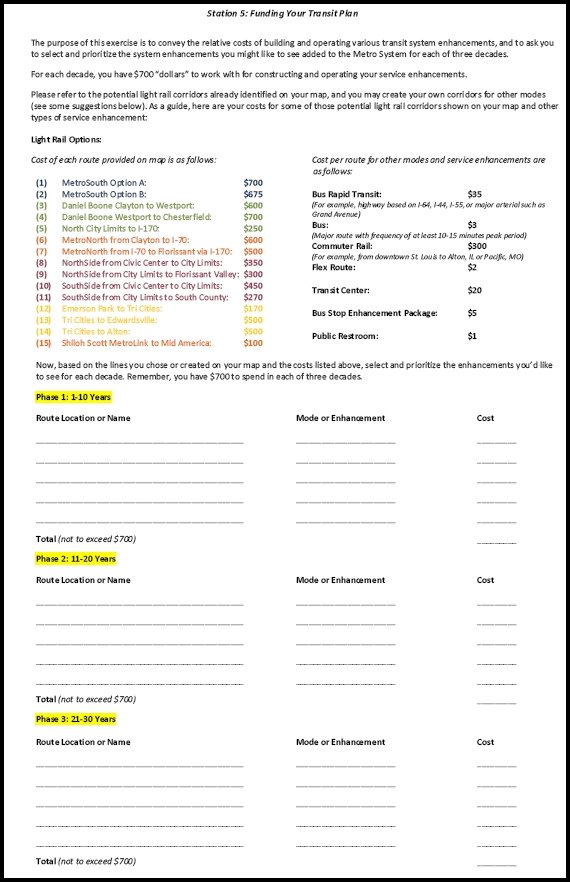
The DC region needs to embark on a wide ranging metropolitan transit (re)planning public process to restore trust in and a common understanding of the WMATA transit system
After the accident in June, which killed 9 people and injured many others, and the continuing problems with safety, financial problems, lack of a regularized funding system, lack of appropriate regulatory oversight, not to mention problems with how the organization is led from the top (both the Board of Directors and top management), it seems reasonable to have a similar kind of regional transit planning exercise here.
Not only would this restore trust in the WMATA system in the DC region, by building a sense that WMATA is accountable to riders, it would also rebuild a regional understanding of what the system is capable of and how it should expand.
It has been 40+ years since the WMATA Metrorail system was first conceived and 33 years since parts of the system began opening. It's time for an assessment/reassessment.
This ought to be preferred over the grab bag of extension proposals in Virginia and Maryland (with little consideration of the impact on the current system) that the system faces currently.
WMATA only sees the world in terms of subway and bus. So the planning process needs to be broader and deeper, focused on transit generally, not just on WMATA operations as they are set up now.
At the same time, such a process should consider truly regional transit planning (which means including railroad service as an option), and the scope of the study should be broad, rather than overly-circumscribed and limited.
WMATA, in conjunction with the Transportation Planning Board of the MWCOG and the local jurisdictions, as well as MARC and VRE and other appropriate state authorities in Maryland and Virginia as well as DC, should launch a planning process similar to that of St. Louis, to come up with a metropolitan transportation plan that allows for transit services to be delivered where they need to be, but one that uses the most appropriate means (heavy rail, light rail, street car, passenger railroad, different types of bus service) to do so.
It should look at funding issues as well as heavy rail expansion where appropriate. That means not just extending transit service outward, but intensifying transit service at the core as well.
Such a planning process should also consider questions of leadership, management, and oversight. As well as funding.
It's the only way to build a truly regional understanding and commitment to transit for the Washington metropolitan region. Without such a planning process, I think we're destined for a lot more of the same incremental and discoordinated transportation planning that we have today.
At the same time, the District of Columbia needs to understand the centrality of transit to the city's economic and competitive advantages, and plan accordingly.
Another example
The Chicago region has a campaign called Moving Beyond Congestion, which could be the model for the St. Louis process.
It's the regional transportation plan normally created by the metropolitan planning organization (tasked by the federal government to coordinate transportation planning in particular metropolitan areas), but in a truly public process, focused on setting the stage for grappling with real needs and hard questions, rather than a more administrative process working between agencies, rather than reaching out to the public.
I tend to believe that these more external planning processes come about when the "s*** has hit the fan" over funding, and the agencies have no choice but to reach out to the public and work to change the political, economic, social, and management frameworks which the transit agencies are currently operating under.
In short, they need a lot more money. And the current setup isn't providing it.
I do think we are at that point in the DC region.
From the Moving Beyond Congestion Strategic Plan:
Our Five Year Investment Lays the Foundation for the Future
Numbers like these are overwhelming until you see what is behind them, so here’s what the five year plan means for you. We divide our capital investments into three categories:
§ Maintain – meaning repairs and upgrades that keep our existing systems in good working order so that there are fewer delays and other problems.
§ Enhance – meaning more and better and faster service without building any major new city or suburban train lines.
§ Expand – meaning new train and bus routes requiring major investments that will cost billions of dollars and take years to complete.
Note that to maintain the transit system in Chicago over five years, $7.3 billion is required. To enhance the system they need $1.1 billion, and to expand, they need at least $2 billion.
But Chicago has a pretty extensive fixed rail transit system already, comprised of extensive El (heavy rail) and railroad passenger service. The DC region lacks as extensive a system, even though compared to many metropolitan regions across the county, our region has a wide ranging heavy rail transit network.
What to do? Planning the next generation of transit in the Washington metropolitan region
The various proposals to extend the Metrorail system in Virginia and Maryland would cost many billions of dollars. And proposals to build the separated blue line in DC, from Arlington, would cost a "few" billion dollars as well.

Polycentric transit service in the DC region, from Belmont, Cities in Full.
At the same time, further deconcentrating the region ("sprawl" versus land use intensification) makes transit less efficient, and proposals to extend the WMATA rail system outward are being made, often in my opinion, without best considering the trip behavior/origin and destination information for subareas (counties) within the region. There are at least six priorities as I see it.
1. Provide more capacity for Metrorail at the core.
Regardless of proposals to extend Metrorail outward, the reality is that the core is freezing up. Regardless of original projections for Metrorail usage that exceed today's projections, the reality is that the system will reach capacity in less than two decades, and even now, station throughput and train capacity needs improvement.
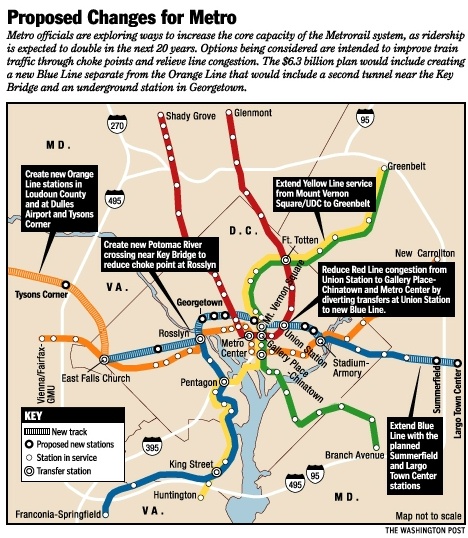
This Washington Post graphic from 2001 shows the proposed separated blue line. This proposal was dropped in 2003 due to financial problems. In a conversation with Matt Johnson (Track Twenty-Nine) he passed on a conversation with WMATA planners talking about "updating" the core capacity study, looking really at "rebuilding" the transit system for new realities and greater use, in thinking about a separated blue line as part of a new transit system being built upon the old. (My words, not his.)
2. Extend Metrorail?
Where Steve Belmont in Cities in Full does criticize the WMATA system as polycentric, designed to support sprawl, it could be that in some situations, it makes sense to extend the heavy rail system further, such as to Fort Belvoir in Fairfax County, or even out to Fort Meade in Maryland (recently discussed in "Imagine the Green Line to Fort Meade" in Greater Greater Washington).
But at the same time, this means making the original Purple Line, which as conceived is a circumferential route (the original concept was heavy rail but now it is being planned as a light rail system) connecting all the legs,should be deemed a regional priority, rather than a project pursued by the separate jurisdictions somewhat independently.
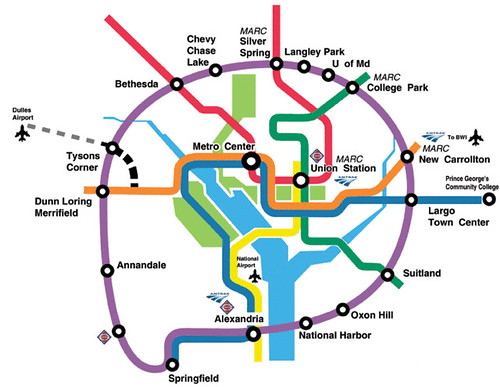
Sierra Club image. The current Purple Line light rail plan in Montgomery and Prince George's Counties, from Bethesda to New Carrollton, is but a "segment" of the total line as it was originally conceived.
3. Change regional land use development policies now, especially those of the federal government.
Sprawl is happening regardless of WMATA, and to reduce automobile use, land use and transportation planning has to be intertwined. It can't be separate. Obviously, land use generates transportation demand.
Someone wrote a letter to the editor in the Gazette, "Metro funding essential to county growth policy," that Montgomery County shouldn't change its growth policy to a transit-complementary policy from the automobile-connected policy it has without being connected to transit planning and funding. They are absolute right.
But it must be emphasized that allowing major land use development, ranging from the military base relocation process which is moving many installations from transit-rich locations to transit-abysmal locations without having taken that into account in the planning process to the location of National Harbor in Prince George's County without ensuring substantive transit connections stresses the road system to levels that can't be corrected.
At the same time, some of these locations have the potential for significantly improved transit service, but not if you don't plan for it at all.
(The model for how to do this comes from the Netherlands. See "Utrecht: 'ABC' Planning as a planning instrument in urban transport policy.")
4. Isn't it time that counties develop complementary surface rail transit programs of their own?
At the end of the day, the WMATA system is focused on DC (and certain other job centers like Bethesda, Crystal City, Rosslyn, etc.). Getting to and from DC from commuters is the backbone of the system, as well as providing intra-jurisdictional service in densely populated communities, especially within DC and to some extent in Arlington County.
Extending the WMATA system outward lengthens trips, requires more equipment and personnel, but at the cost of trip time and money. It's not clear that such extensions adequately leverage what the system does best.
I think that rather than considering extending Metrorail out to Potomac Mills ("Prince William Democrats Push Proposal to Extend Metro to Traffic-Snarled Area: Lawmakers Push Transit Extension" from the Post) it might make more sense for counties like Fairfax to develop streetcar and light rail plans of their own, complementing WMATA's heavy rail system and railroad stations, but focused on providing transit that actually will be heavily used, and to begin the repatterning of land use and transportation policy and practices in a more focused manner.
This is what is happening with the creation of the Purple Line light rail system in Montgomery and Prince George's Counties. But it needs to be extended as a model for other counties in approaching their own transportation needs, but in a manner which leverages and complements the Metrorail system.
See the past blog entry, "Reprint (with editing): The Meta-Regional Transit Network," which discusses the concept of the metropolitan transit network and the various center city and suburban subnetworks within it.
These articles, "Fort Meade proposes Metro extension: Master plan includes adding to rail line to accommodate new jobs" from the Baltimore Sun (2009) and "Plan for Metro to BWI Gaining Momentum" (2006) from the Post, and towards Charles County "Prince George's Sees Andrews As Hub of Development" (2007) from the Post discuss other proposals to extend the Metrorail system.
Note that Arlington's Transit Element in their Transportation Plan is a model for county-specific plans, as is their pursuit, with Fairfax County, of the creation of a streetcar route on Columbia Pike.
5. Expand and extend passenger railroad services.
The farther a location is from the core of the region, the more likely passenger railroad service makes sense. Plus, a passenger railroad system shouldn't be focused on only serving commuters, but the region, and ideally, it should be one seamless service, rather than a collection of services (Maryland and Virginia have separate services) at present.
See the past blog entry "A regional railroad passenger transportation vision for DC, MD, VA, WV and parts of PA (and Delaware)" for more on this topic.
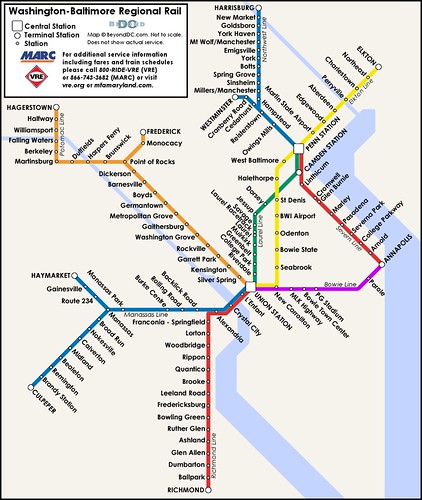
Early ideas for a Washington-Baltimore-Northern Virginia regional passenger rail system from Beyond DC.
I can't remember which blog suggested having additional railroad stations within DC and Northern Virginia beyond Union Station as a way to improve overall throughput on both the railroad and for those subsequently transferring to the subway, but that is something that needs to be put on the table as well. Models are the three railroad stations in Philadelphia (Market Street, Suburban Station, and 30th Street) which because they were serving either the Pennsylvania Railroad or the Reading Railroad they weren't originally connected--now they are, or railroad service in London and Paris. (Although DC doesn't have the kind of density of population or employment possessed by either London or Paris.)
6. Continued improvements in bus transportation and customer service.
In the blog entry "The revised revised People's Transportation Plan/2008 Transit-Transportation wish list I wrote about this extensively and don't feel it needs to be updated much. There were 8 major recommendations, although some are more specific to DC:
• Improve the bus service. I say do this before thinking about streetcars. We need to make bus service exciting and sexy, in order to boost transit use. I recommend better marketing and wayfinding systems, better bus shelters (coming) and waiting stations, and probably sexier buses, which to my way of thinking, would be double deckers, on routes that could accommodate them. Double deckers are 40 feet long, and more maneuverable than 60 foot articulated buses.
• Create intra-neighborhood transit (bus) services so that people can get to and from local services, commercial districts, schools, libraries, and to and from transit stations without having to drive. (This is a DC specific recommendation)
• making intra-neighborhood transit service free (Tempe's Orbit bus service is an example of how to do it). (This is a DC specific recommendation)
• Dumping what I call political bus service--bus service that ought to be reconfigured because it is not cost effective but isn't because of political posturing. But it wastes money and deserves other segments of the transit market. (This is a semi-DC specific recommendation)
• Improve all "transit waiting environments" (not just for bus service, but on the subway too).
• Significantly improve transit marketing.
• Create a system of regional "Mobility" stores to market walking, bicycling, and transit to residents and commuters, but as a lifestyle, not merely as mode shift for commuters. (Based on what Arlington is already doing.)
• Improve wayfinding and transit information.
Conclusion
In short, it's a pretty big charge for a regional transit plan, but it needs to be done. And the longer one avoids such a process, the harder it is to do, and the more necessary.
Labels: development oriented transit, mobiliy, railroads, transit and economic development, transit funding, transit infrastructure, transportation planning



0 Comments:
Post a Comment
<< Home